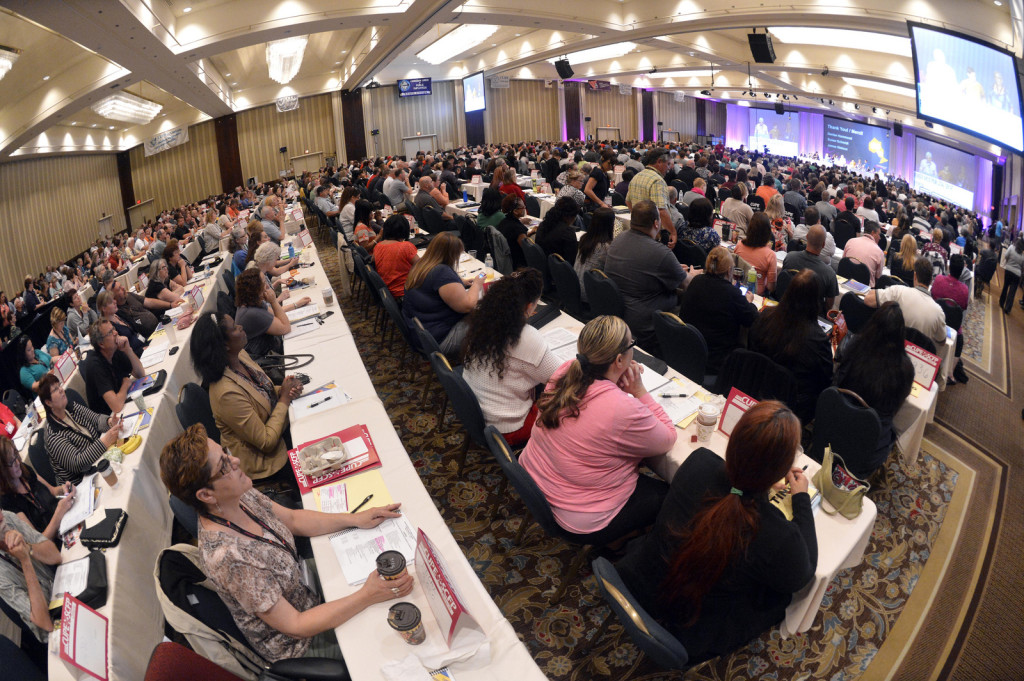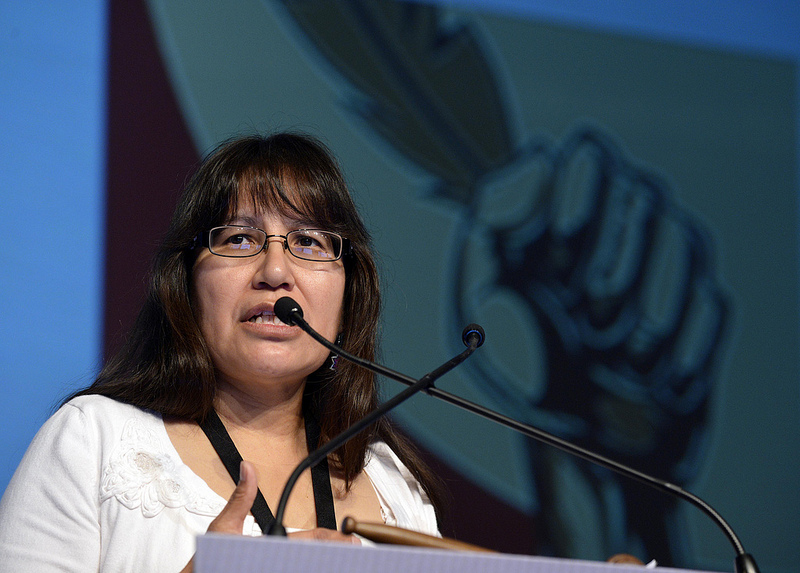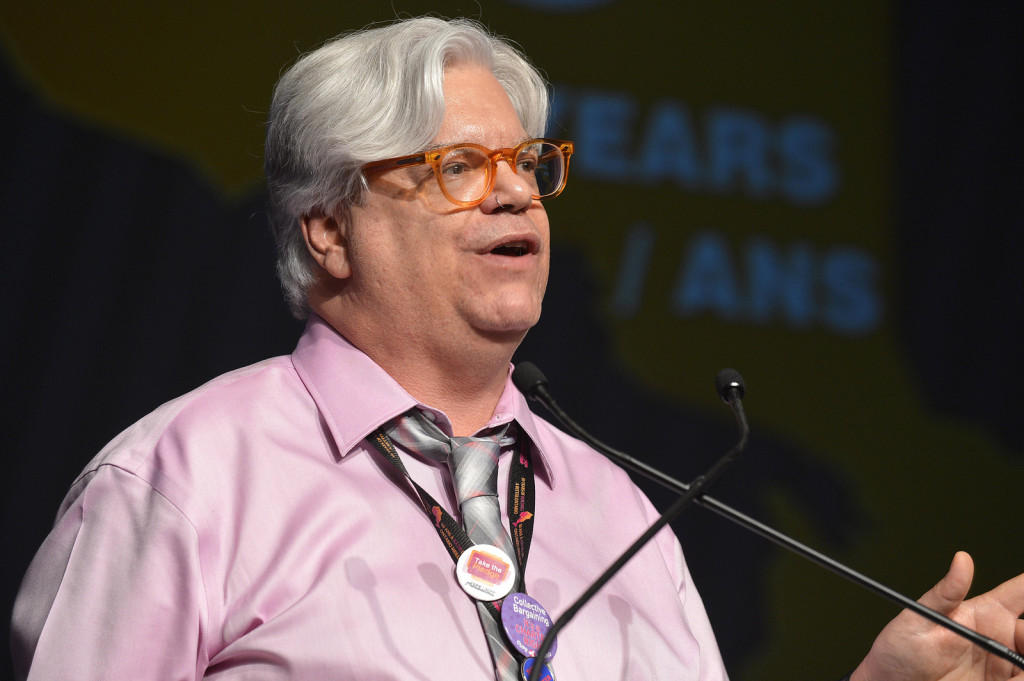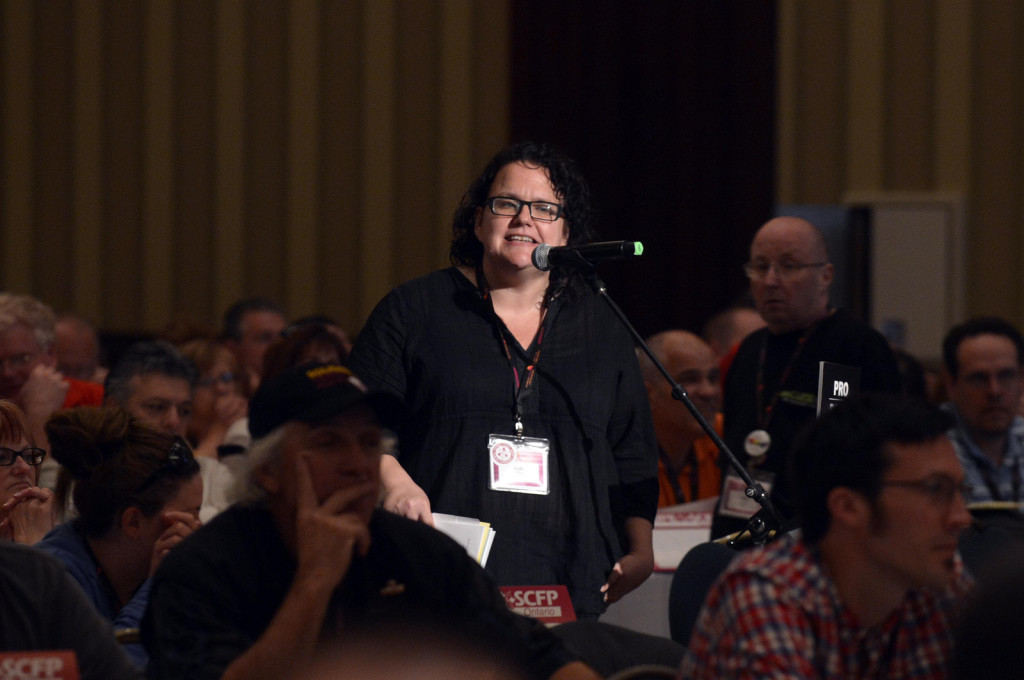by Steve da Silva, CUPE 3903, rank-n-file member

Nearly 900 delegates and about 1100 were in attendance for CUPE Ontario’s 50th Annual Convention.
This past weekend the Ontario division of the Canadian Union of Public Employees (CUPE) –Canada’s largest union, with 650,000 members – wrapped up its 50th annual convention. The milestone convention saw nearly half of its 5-day agenda taken up with celebrating the union’s past achievements and recognition and awards ceremonies. But the dark cloud of the austerity offensive cast a shadow over the attendees, with delegates anxious to get down to strategizing for the battles ahead.
The other half of the convention was dedicated to discussing the dozens of resolutions and campaigns representing workers in the various sectors organized by the union, with a particular focus on the union’s ‘2013 Action Plan,’ the centerpiece of the union’s strategy over the coming year in the face of major attacks being planned.
Among the countless attacks on workers in every workplace and sector, the greatest feared by union leaders are the plans of Conservatives at both provincial and federal levels to eliminate the ‘Rand formula’ – a law passed in late 1940s that ruled that every member of a unionized workplace has to pay union dues since they benefit from being protected by a union. Similar to such ‘Right to Work’ legislation passed in the United States, such a move would drain resources from unions. Eliminating the Rand formula would not spell an end to working-class resistance, but it would wipe away the ability of unions to mobilize resources – an especially troubling prospect for the handsomely paid upper-brass of the unions.

Sylvia McAdam, one of the four original founders of Idle No More, spoke to CUPE Ontario’s 50th Annual Convention.
The opening day began with speeches from labour allies, including Sid Ryan, President of the Ontario Federation of Labour and continued with reports from CUPE National President, Paul Moist, and CUPE Ontario President Fred Hahn. The Convention acknowledged Idle No More (INM) on its second day with a guest speech from one of its original Saskatoon founders, Sylvia McAdam. But this recognition did not extend to actually absorbing some of the most important lessons of INM: the power and effectiveness of street protest over political lobbying and reducing politics to electoral contests. McAdam, who was previously a strong advocate of exclusively peaceful protest , acknowledged how INM has had to adapt over time and cited INM’s new allies, such as the Defenders of the Land network , who INM joined together with in calling for a “Sovereignty Summer” to consist of direct actions such as blockades.
After more than two days of unwavering support for the NDP through speeches and presentations from the Convention organizers, opposition to the question of the union’s relationship to the NDP appeared immediately after a speech by Ontario NDP leader Andrea Horwath.

CUPE Ontario President used nearly all the opportunities possible in his leading position at the Convention to affirm the union’s relationship to the NDP, assuring the membership that the NDP’s policies are “not perfect” but that it was the closest party to our interests…
Horwath was supposed to have given us time at the Convention “to hear from us,” but instead she presented at us for most of the hour. Many noticed how visibly nervous Horwath seemed as she began to field questions from CUPE Ontario members. After fielding a few very soft questions – about which she was nonetheless evasive and provided what seemed like scripted responses surely heard by countless others already – Horwath excused herself from the Convention of a union representing more than 200,000 workers for a “4 o’clock meeting” – leaving a couple dozen members at the mic with unanswered questions. CUPE Ontario President Fred Hahn rushed to Horwath’s defense, assuring delegates that she had made it known to him in advance that she could only spare one hour. Members in queue were told to submit questions in writing to be forwarded to Horwath later.
But questions about the NDP immediately spilled over into the subsequent debate around the centerpiece of the convention – its draft ‘2013 Action Plan’. Particularly contentious was the Action Plan’s call to support the NDP in elections – which while appearing on only a single line was the core of the document’s electoralism and which became the exclusive focus of the Action Plan debate at the Convention.
The text of the Action Plan opened with a call for ‘new tools’ for the union – and “a whole new scale of mobilization and a major offensive to preserve the rights of workers.” But instead, what was tabled was a document more or less reaffirming the orientation to the NDP and electoral contests.
One lunchtime workshop on the first day of the Convention was chaired by the NDP-oriented consulting firm Public Interest, which BASICS has in the past warned residents in Toronto social housing about, given their pro-“revitalization” stance and efforts to block grassroots tenants organizing . The consulting firm made a presentation to CUPE members on how to challenge Toronto wards most weakly held by conservative incumbents. And the union brass’s idea of “political education” was rolling out a campaign during the convention to sign up its members for training in upcoming elections.
Yet, reflecting a disconnect between rank-n-file delegates and the leadership, three quarters of the membership who lined up to vocalize their thoughts on the pro-NDP orientation expressed opposition to or questioned openly tying the union to the NDP. Among other critiques, delegates identified how Andrea Horwath’s support for the Kathleen Wynne Liberal government has hurt CUPE members and the working class; or how the NDP is often absent when actual labour confrontations arise.

Kelly O’Sullivan, President of CUPE 4308 and well-known activist in Toronto’s downtown eastside.
Kelly O’Sullivan, President of CUPE 4308, a union of personal support workers, told BASICS that “NDP support for the Liberals has had a direct impact on delegates at convention – their support of an austerity budget with funding freezes for hospitals, lack of action on Ontario Northland are examples.”
O’Sullivan threw into question the connection of the NDP to the working class, and her locals members: “[Horwath’s] budget support with a call for a 5-day wait time in home care ignores the reality that our sector is and will continue to be predicated on low-waged precarious work for personal support workers – who are overwhelmingly women, racialized and working-class… This is another example of the disconnect between the lived reality of our members and the lack of connection the NDP has with the working class.”
O’Sullivan of CUPE 4308 observed that there was “no organized ‘left’ or socialist caucus within CUPE Ontario to support, advocate or intervene around action plans or develop strategies.” Yet in spite of this, a redraft of the Action Plan which removed reference to the NDP continued to draw more support than opposition in a subsequent debate. It was noteworthy point that NDP supporters at the Convention could not outnumber members standing up and questioning the union leadership’s unwavering support for the party. However, a compromise clause was eventually devised which reconciled the difference with a clause to support “NDP and pro-working class candidates.” One delegate remarked on the irony of calling for supporting candidates that are not covered by the phrase “pro-working-class.”
To be clear, this sentiment was clearly coming from the left, and not in favour of a more rightward leaning to the Liberal party, as has been the practice of the teachers unions.
Farid C. Partovi of Local 4772 told BASICS that we had “an important debate at the CUPE Ontario convention on the NDP in Ontario supporting the Liberal government’s budgets and policies that I think are in direct contrast to the public sector workers’ and the working class’s resistance against austerity agenda. The adopted action plan … includes progressive positions on numerous issues and actions; however, it does not directly tackle this serious problem. I think it’s long overdue for us as workers and CUPE members to seriously confront these kinds of politics and push for a progressive agenda that stands only for the interest of the working class as a whole and its fight against global capitalist exploitation, corporate agenda and neo-liberal austerity measures.”
As the austerity attacks continue to gut public services, starve communities, and attack the labour rights and wages of workers, the need for unity is pressing – but not unity around failed or failing strategy.
If public sector workers and the working-class in general are going to resist governments’ attempts to displace capitalism’s problems onto workers and the broad masses of people, we do indeed require “a whole new scale of mobilization and a major offensive to preserve the rights of workers,” as our Action Plan called for. But staking the union’s and the working class’s future on a party that hardly maintains a pretense of being of and for the working-class is beyond bankrupt, a matter of fact that rising numbers of workers are coming to realize.
Comments

Comrade Steve DaSilva, excellent reporting on the farce that is CUPE’s relationship with the NDP.
The “policy bone” thrown to what is generously called “the left” in trade unions means nothing because once convention is over the class-collaborators or union bureaucrats will spend the members’s resources in whatever way they desire.
CUPE Ontario will line up behind the NDP in the next election. I do not believe that anyone out there would like to bet against my assertion.
Many members of the so-called labour left have no problem lining up behind the class-collaborators or union bureaucrats during elections at conventions.
The working-class revolution will not be the result of speeches and resolutions at trade union conventions!
There is a clear need for a comprehensive strategy in CUPE, no doubt. However, after this Convention especially it’s equally clear that “the Left” has no idea what that strategy actually looks like or how to mobilize rank-and-file members. There’s a big gulf between the rhetoric used at mics around politics and what we hear from rank-and-file members in, say, school boards and municipalities. We’re talking about Locals that don’t support the NDP not because they’re “too right wing”, but because “if we support the NDP we have to support all parties, and we don’t tell our members how to vote.” How do we, as a union, reconcile that?
I think you’re right “Green-Jello-Sucks”, that ‘the left’ has no idea what strategy looks like for mobilizing rank-n-file members. So let’s start a bit of a conversation why this is the case:
For one, I’m generally loathe to use the phrase “the left”, because it’s usually followed by generalizations that are tough to maintain when we differentiate its component parts. If ‘the left’ has no strategy for union mobilization, it’s because there is no coherent or even substantial current in this city, province, or country that can claim to be “the left”. There are many leftists, but at this time not a single force, at this time, with a programmatic approach or strategy for challenging austerity and rebuilding labour militancy. Many of the Trotskyite sects (Fightback, I.S., Socialist Action) basically advocate some form of agitation within the NDP and opt for burrowing their way into labour bureaucracies or entrenching themselves in this or that union. Some of the old-school and generally stagnant “Communist Parties” choose the latter tactic and rail against the NDP – but don’t really bring any strategy except for getting themselves into positions of leadership.
And much of the rest of the more energetic and creative left (but generally directionless) that actually organize people – have tended to buck union politics, and historically for the good reason that unions were indifferent if not hostile to the communities they organize (migrant workers, immigrant communities, working poor and neighbourhood-based work). These currents tend to see themselves as anarcho-postmodernist, anarcho-communist, or communist terms – and see in the unions a lot of people who don’t care about workers outside of the unions.
And if the left is generally an absent or irrelevant force in the union movement, there are historical reasons for this too: Although the most energetic labour organizers in the opening decades of the last century were socialists, communists, or anarchists, that all changed with the instituationalization of labour politics and the prevalance of labour peace after WWII. After the Rand formula, and in the opening years of the Cold War, the social democratic unionists allied with management and government to chase communists out of the unions; and that mass purge was never really reversed – mostly because unions were not really fertile ground in the expanding economy of the first couple Cold War decades.
And the tendency of our membership to view things in “pragmatic” terms of just voting for whatever party seems to best suit their interests is just a reflection of a couple generations of a relatively stable capitalist economy, where people who descend from the working-class forget that party politics is ultimately how we built our organizations and carved out whatever rights we have. And that point applies whether you’re a social democrat or a communist (though it must be said that the former largely inherited the rights fought for by the latter). I think as income inequalities worsen, the economic crisis spirals deeper, and austerity attacks intensify, the principle of non-partisanship will seem increasingly idiotic.
All in all, we need to engage rank-n-file members; and my general view on rank-n-file’s inactivity is generally a reflection of the indifference if not contempt for leadership and hence unwillingness to engage.
Nice to see a conversation started here. I hope it continues…
-Steve da Silva